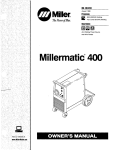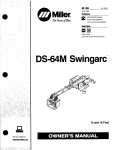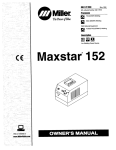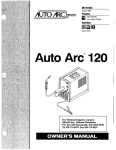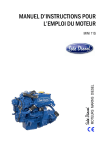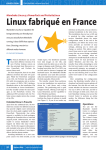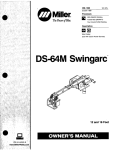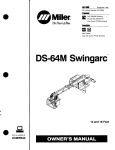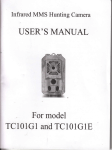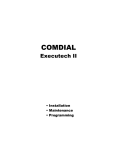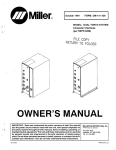Download Miller Electric VL-M4 Specifications
Transcript
OM189 580 Miller April 1998 Eff. w/Serial Number KJ0991 10 Processes MIG Vie Power ~fB1ue. (GMAW) Welding Submerged (SAW) Welding Description O Submerged Arc Controller Welding For Automatic MILLER VL-M4 0 Visit our website at www.MlHerWehts.com OWNERS MANUAL From Miller to You Thank you and you get the can have time to do it any other way. you dont Thats congratulations on choosing Miller. Now~ job done and get it done right. We know why when Niels Miller first started building arc welders in 1929, he made sure his products offered long-lasting value and superior quality. Like you, his customers couldnt afford anything less. Miller products had to be more than the best they could be. They had to be the best you could buy. people that build and sell Miller products continue the tradition. Theyre just as committed to providing equipment and service that meets the high standards of quality and value established in 1929. 5?1~JII~LOT! This Owners jOWIt:1DHPCefrOrn~:Mlite~1S~:~ Today, the Working az hard as you do Miller help Manual is products. you designed help you get the most out of your Please take time to read the Safety precautions. They will to protect yourself against potential hazards every baCked b~:the fliost kassIe~iree~ warranty in the businesa the worksite. Weve on made installation and operation quick and easy. With Miller you can count on years of reliable service with proper maintenance. And if for ~I iJ~J~ ~ 1 1 I REGISTERED the unit needs repair, theres a Troubleshooting section that will help you QUALITY SYSTEM some reason V Miller is the first welding equipment manulathwer In the U.S.A. to he registered to Ibe ISO oooi Quality System Standard. figure out will then what the help problem is. The parts list you to decide which exact part you may need to fix the problem. Warranty and service information for your particular model are also provided. Miller offers a Technical Manual which provides more detailed seivice and parts information for your urnf To obtain a Technical Manual, contact your 1Q08!:::: distributor Your distributor can ~lso supply ył~ With WeldIn9 Process Manuals such as SM.4W OTAW GMAW and QMAWP Miller Electric manufactures of welders and welding For information products, to on other equipment. quality Miller contact your local Miller distributor catalog \ full line related receive the latest full line individual a catalog or sheets. To locate your nearest distributor call 1-800-4-A-Miller. O~~ TABLE OF CONTENTS SECTION 1 1-1. - SAFETY PRECAUTIONS - READ BEFORE USING 1-4. Symbol Usage Arc Welding Hazards Additional Symbols for Installation, Operation, Principal Safety Standards 1-5. EMF Information 1-2. 1-3. SECTION 1 1-1. 1-2. 1-3. - 1 1 and Maintenance - Signification des symboles Dangers relatifs au soudage a arc Dangers supplØmentaires en relation normes 1-5. Information sur SECTION 2 - Weld Control 2-2. Description 3-1. 3-2. 3-3. 3-4. - 5 avec linstallation, le fonctionnement 7 de sØcuritØ champs ØlectromagnØtiques INSTALLATION Typical Equipment Location Mounting Hole Layout Connection Diagram Connecting Shunt Control 8 8 9 9 9 10 10 10 11 12 3-5. Left Side Panel Connections 12 3-6. Strip TEl Connections Terminal Strip TEl Connection Information Remote 14 Receptacle RC2 Information Terminal Strip TE2 Connections Terminal Strip TE2 Connection Information Remote 17 Receptacle RC1 Information Remote 5 Receptacle RC3 Information Start / Stop Connections For Two (2) Units 13 3-7. 3-8. 3-9. 3-10. 3-11. 3-12. 3-13. Terminal SECTION 4 - OPERATION 14 14 15 16 16 16 17 17 4-1. Safety Equipment 17 4-2. Front Panel Controls 18 4-3. Inside Panel Controls SECTION 5- MAINTENANCE & TROUBLESHOOTING 5-1. Routine Maintenance 5-2. Replacing Fuses 19 20 20 20 SECTION 6- ELECTRICAL DIAGRAM 22 SECTION 7 23 - WAR RANTY OM-189 530 5 5 SPECIFICATIONS 2-1. SECTION 3 les 3 LIRE AVANT UTILISATION et Ia maintenance Principales 3 4 CONSIGNES DE SECURITE 1-4. 1 PARTS LIST SECTION 1 SAFETY PRECAUTIONS - READ BEFORE USING - nd5/97 som Symbol Usage. 1-1. Means AA A Marks a There not safety hazards are This group of symbols means Warning! Watch Out! possible ELECTRIC SHOCK, MOVING PARTS, and HOT PARTS hazards. Consult symbols and related instructions below for necessary actions to avoid the hazards. related. Welding Hazards are used throughout this manual identity possible hazards. When you shown below symbols to call attention to and seethe possible are special safety message. Arc 1-2. The Out! Watch procedure! The possible adjoining symbols. shown in the ~ Means Note~ A Warning! hazards with this symbol, watch out, and tollowthe related instructions safety information given below is to avoid the hazard. The a summary of the more complete safety information found in the Safety Standards listed in Section 1 -4. Read and follow all Safety. Standards. If earth with grounding of the separate cable a - workpiece is do not work use required, ground it directly clamp or work cable. Do not touch electrode if you are in contact with the another electrode from a different machine. work, ground, or only A A Only qualified persons repair this unit. should install, operate, maintain, and During operation, keep everybody, especially children, away. Use only well-maintained equipment. Repair or replace damaged at once. Maintain unit according to manual. parts safety Wear a Keep all Clamp work or worktable can kill as near above floor level. securely in place. metal-to-metal contact to good the weld as workpiece practical. clamp when not connected to workpiece to prevent object. contact with any metal Do not connect live electrical parts can cause fatal shocks or severe burns. The electrode and work circuit is electrically live whenever the output is on. The input power circuit and machine internal circuits are also live when power is on. In semiautomatic or automatic wire welding, the wire, wire reel, drive roll housing, and all metal parts touching the welding wire are electrically live. Incorrectly installed or improperly grounded equipment is a hazard. Touching working and covers cable with Insulate work ELECTRIC SHOCK harness if panels more than one electrode or work cable to any single weld output terminal. SIGNIFICANT DC VOLTAGE exists after removal of input power on inverters. Turn Off inverter, disconnect input power, and discharge input capacitors according to instructions in Maintenance Section before touching any parts. Do not touch live electrical parts. Wear dry, hole-free insulating gloves and body protection. FUMES AND GASES Insulate yourself from work and ground using dry insulating mats or covers big enough to prevent any physical contact with the work or ground. Do not use AC output in damp areas, if movement is confined, there is a danger of falling. Use AC output ONLY if If AC output is required, required use for the remote or Disconnect output control if present on Properly Owners power or stop engine before installing or equipment. Lockout/tagout input power according CFR 191 0.147 (see Safety Standards). input this to OSHA 29 install and ground this equipment according to its Manual and national, state, and local codes. Always verity the supply ground check and be sure that input power cord ground wire is properly connected to ground terminal in disconnect box or that cord plug is connected to a properly grounded receptacle outlet. - When making input connections, conductor first - attach proper grounding double-check connections. Frequently inspect input power cord for damage or bare wiring replace cord immediately if damaged bare wiring can kill. - - Turn off all Do not Do not equipment use worn, drape when not in over If ventilation is poor, Read Material the manufacturers your body. poorly spliced cables. and gases. Breathing be hazardous to your can use an use exhaust at the arc to approved air-supplied respirator. Data Safety Sheets instructions for metals, (MSDSs) and the consumables, coatings, cleaners, and degreasers. confined space only if it is well ventilated, or while air-supplied respirator. Always have a trained watchperson nearby. Welding fumes and gases can displace air and lower the oxygen level causing injury or death. Be sure the breathing air is safe. Work in a wearing an Do not weld in locations operations. form highly near degreasing, cleaning, The heat and rays of the arc toxic and irritating gases. Do not weld on coated plated steel, weld area, the or be hazardous. head out of the fumes. Do not breathe the fumes. If inside, ventilate the area and/or remove welding fumes and gases. cadmium use. damaged, undersized, cables these fumes and gases health. Keep your unit. servicing Welding produces fumes if welding process. can area metals, such unless the is well can as coating or spraying react with vapors to galvanized, lead, or is removed from the ventilated, and if necessary, while wearing an air-supplied respirator. The coatings and any metals containing these elements can give off toxic fumes if welded. OM-189 530 Page 1 BUILDUP OF GAS ARC RAYS can burn eyes and skin Shut off Arc rays from the welding process produce intense visible and invisible (ultraviolet and infrared) rays that can burn eyes and skin. Sparks fly off from the weld. can injure kill or not in shielding gas supply when confined ventilate spaces Always approved air-supplied respirator. awelding helmet fitted with a propershade of filter to protect your face and eyes when welding or watching (see ANSI Z49.1 and Z87.1 listed in Safety Standards). use. or use Wear Wear approved safety glasses HOT PARTS can cause severe helmet. Do not touch hot protective screens or barriers to protect others from flash and glare; warn others not to watch the arc. Allow Use Wear burns. with side shields under your parts cooling period bare handed. before working on gun or torch. protective clothing made from durable, flame-resistant (leather and wool) and foot protection. material MAGNETIC FIELDScan affect pacemakers. WELDING can cause fire or explosion. Pacemaker keep away. wearers Wearers should consult their doctor before closed containers, such as tanks, can causethem to blow up. Sparks can fly off from the welding arc. The flying sparks, hot workpiece, and hot equipment can cause fires and burns. Accidental contact of electrode to metal objects can cause sparks, explosion, overheating, orfire. Check and besurethe area is safe before doing any welding. Protect Welding on drums, pipes, yourself or and others from Do not weld where flying sparks flying sparks can going near arc welding, gouging, welding operations. NOISE can or spot damage hearing and hot metal. Noise from some processes strike flammable material. equipment or can damage hearing. Remove all flammables within 35 ft (10.7 m) of the welding arc. If possible, tightly cover them with approved covers. approved Wear this is not ear protection if noise level is high. Be alert that welding sparks and hot materials from welding can easily go through small cracks and openings to adjacent areas. Watch for fire, and keep Be that aware fire can cause Do not weld on welding on a fire on a extinguisher nearby. ceiling, floor, bulkhead, closed containers such tanks, drums, as they are properly prepared according Safety Standards). unless or as close to the welding area as prevent welding current from traveling long, possibly unknown paths and causing electric shock and fire hazards. Do not to use can explode if damaged welder to thaw frozen Shielding gas cylinders contain gas under high pressure. If damaged, a cylinder can explode. Since gas cylinders are normally part of the welding process, be sure to treat them carefully. pipes, (see to AWS F4.1 Connect work cable to the work practical CYLINDERS partition or the hidden side. Install pipes. compressed gas cylinders from excessive heat, slag, open flames, sparks, and arcs. Protect mechanical shocks, cylinders in an upright position by securing to a stationary or cylinder rack to prevent falling or tipping. support Remove stick electrode from holder contact tip when not in Wear oil-free or cut off welding wire at use. protective garments such as leather gloves, heavy high shoes, and a cap. shirt, cuffless trousers, Remove any combustibles, such as a butane from your person before doing any welding. FLYING METAL can lighter or matches, Injure eyes Keep cylinders away from any welding Never drape Never allow Never weld a a welding welding on a torch over a or gas Welding, chipping, cause sparks and flying they can throw off slag. grinding metal. As welds cool, approved safety glasses with side shields even under your welding helmet. Wear OM-189 530 Page 2 cylinder. electrode to touch any pressurized cylinder - cylinder. explosion will result. Use only correct shielding gas cylinders, regulators, hoses, fittings designed for the specific application; maintain them associated parts in good condition. Turn face away from valve outlet when wire brushing, and other electrical circuits. Keep protective cap use or in connected for place over valve opening cylinder except when and and valve. cylinder is in use. Read and follow instructions on compressed gas cylinders, equipment, and CGA publication P-i listed in Safety associated Standards. 1-3 Additional ~ 4 For Symbols Installation, Operation, And Maintenance FIRE OR EXPLOSION hazard. MOVING PARTS Do not install place or unit on, over, Keep away or near combustible surfaces. ] Do not install unit Do not overload is can cause injury. . building wiring properly sized, rated, and near be - flammables. sure power cause fans. guards injury. eye to lift unit only, NOT running gear, gas cylinders, or any other accessories. Use as supply system H.F. RADIATION Use such moving parts to handle this unit. protected FALLING UNIT can from all doors, panels, covers, and closed and securely in place. Keep can cause interference. lifting High-frequency (H.F.) can interfere with radio navigation, safety services, computers, and communications equipment. Have only qualified persons familiar with electronic equipment perform this installation. equipment of adequate capacity to lift and support unit. If using lift forks to move unit, be sure forks are long enough to extend beyond opposite side of unit. The for responsible is user having a qualified electrician problem resulting from the correct any interference promptly installation. OVERUSE Allow cooling period; Reduce current starting or STATIC (ESD) Put or on follow rated reduce duty cycle. duty cycle before again. to weld Do not block handling OVERHEATING can cause filter airflow to unit. can grounded boards or If notified by equipment at once. the FCC about Have the installation regularly interference, stop using the checked and maintained. Keep high-frequency source doors and panels tightly shut, keep spark gaps at correct setting, and use grounding and shielding to minimize the possibility of interference. damage PC boards. wrist strap BEFORE parts. ARCWELDING an Use proper static-proof bags and store, move, or ship PC boards. cause interference. boxes to Electromagnetic energy can interfere with electronic equipment such as computers and computer-driven equipment sensitive MOVING PARTS can cause such injury. Keep away from Keep away moving parts. from pinch points as robots. all equipment in the welding electromagnetically compatible. Be such as drive To reduce possible, rolls. sure WELDING WIRE can cause injury. possible interference, keep weld cables as short as together, and down low, such as on the floor. Be welding operation equipment. sure according Do not press gun trigger until instructed to do so. Do not point gun toward any part of the body, people, or any metal when threading welding wire. is close Locate tronic area this welding 100 meters from any sensitive elec machine is installed and grounded to this manual. If interference still occurs, the user must take extra measures as moving the welding machine, using shielded cables, such using line filters, or shielding the work area. other 1-4. Principal Safety Standards Safety in Welding and Cutting, ANSI Standard Z49. 1, from American Welding Society, 550 N.W. LeJeune Rd, Miami FL 33126 Safety and Health Standards, OSHA 29 CFR 1910, from Superinten dent of Documents, U.S. Government Printing Office, Washington, D.C. 20402. Recommended Safe Practices for the Preparation for Welding and Cutting of Containers That Have Held Hazardous Substances, American Welding Society Standard AWS F4.1, from American Welding Society, 550 NW. LeJeune Rd, Miami, FL 33126 National Electrical Code, NFPA Standard 70, from National Fire Batterymarch Park, Quincy, MA 02269. Protection Association, Safe Handling of Compressed Gases in Cylinders, P-i, from Compressed Gas Association, Highway, Suite 501, Arlington, VA 22202. CGA Pamphlet 1235 Jefferson Davis Code for Safety in Welding and Cutting, CSA Standard Wi 17.2, from Canadian Standards Association, Standards Sales, 178 Rexdale Boulevard, Rexdale, Ontario, Canada M9W 1 R3. Safe Practices For Occupation And Educational Eye And Face Protection, ANSI Standard Z87.i from American National Standards Institute, 1430 Broadway, New York, NY 10018. And Welding Processes, NFPA Standard 51 B, from National Fire Protection Association, Batterymarch Park, Quincy, MA 02269. Cutting OM-189 530 Page 3 .1-5. EMF Information Considerations About Welding And The Effects Of Low Electric And Magnetic Fields Frequency 1. Keep cables Welding current, as it flows through welding cables, will cause electromagnetic fields. There has been and still is some concern about such fields. However, after examining more than 500 studies spanning 17 years of research, a special blue ribbon committee of the National Research Council concluded that: The body of evidence, in the committees judgment, has not demonstrated that exposure to powerfrequency electric and magnetic fields is a human-health hazard. However, studies are still going forth and evidence continues to be 2. Arrange 3. Do not coil examined. Until the final conclusions of the research are reached, you may wish to minimize your exposure to electromagnetic fields when welding To or magnetic procedures: OM-189 530 or one or taping side and away from the them. operator. drape cables around your body. Keep welding power practical. source Connect work to 4. and cables as far away from opera- tor as 5. clamp workpiece as close to the weld as possible. fields in the workplace, use the following Pacemakerwearersconsultyourdoctorfirst. If cleared by yourdoctor, following the above procedures is recommended. then Page cables to together by twisting About Pacemakers: cutting. reduce close 4 SECTION 1 - CONSIGNES DE SECURITE UTILISATION LIRE AVANT - som 1-1 Signification Identifie fl~ Signifie NOTA; un nest etauxdirectives ci-dessous at in de connaItre les Øviter tout danger. pas relatif a Ia sØcuritØ. Dangers relatifs 1-2 au soudage a symboles prØsentØs ci-aprŁs present manuel A Linstallation, Iutilisation, lentretien et les reparations des personnes qualifiees. vent Œtre confiØs qu A Au coursde ne doi lutilisation, tenirtoute personne a lØcartet plus par ticuliŁrement es mesures a prendre pour Iarc sont utilisØs tout au long du pour attirer votre attention et identifier les risques de danger. Lorsque vous voyez un symbote, soyez vigilant et suivez les directives mentionnØes atm dØviter tout danger. Les consignes de sØcuritØ prØsentØes ci-aprŁs ne font que rØsumer linformation contenue dans les normes de sØcuritØ ØnumØrØes a Ia section 1 -4. Veuillez lire et respecter toutes ces normes de sØcuritØ. Les F1 Ce groupe de symboles signifie Mise en garde Soyez vigilant Ily a des risques de danger relies aux CHOCS ELECTRIQUES, aux PIECES EN MOUVEMENTetaux PIECES CHAUDES. Reportez-vous auxsymboles message de sØcuritØ particulier. A 5/97 symboles Signifie Mise en garde Soyez vigilant! Cette procedure prØsente des risques de danger! Ceux-ci sont identifies par des symboles adjacents aux directives. a A des _nd_fre Ne pas toucher lŁlectrode terre ou une quand on est en contact avec Ia piŁce, Ia electrode provenant dune autre machine. Nutiliser quun materiel en bon Øtat. RØparer ou remplacer sur-le champ les piŁces endommagØes. EntretenirlappareilconformØment a ce manuel. Porter harnais de sØcuritØ quand un Maintenir solidement en place on travaille hauteur. en tous les panneaux et capots. Fixer le cable de retour de facon a obtenir un bon contact mŁtal-mØtal avec Ia piŁce a souder ou Ia table detravail, le plus prŁs possible de Ia soudure. enfants. Isoler Ia pince de masse quand pas Objet metallique. mis a Ia piŁce pour Øviter le contact avec tout UN CHOC ELECTRIQUE Un simple contact avec des peut tuer piŁces Ølectriques peut provoquer une electrocution ou des blessures graves. LØlectrode et le circuit de soudage sont sous tension des que lappareil est sur ON. Le circuit dentrØe et les circuits internes de Iappareil sont egalement sous tension ace moment-l. En soudage semi-automatique ou automatique, le fil, le dØvidoir, le logement des galets dentraInement et les piŁces metalliques contact avec le fit de soudage sont sous tension. Des ou mal mis a Ia terre prØsentent un danger. en Ily a DU COURANT CONTINU IMPORTANT dans les convertisseurs aprŁs Ia suppression de Ialimenta tion Ølectrique. ArrŒter les convertisseurs, dØbrancher le courant electrique, et dØ charger les condensateurs dalimentation selon les instructions indiquees dans Ia partie entretien avant de toucher les piŁces. matŁriels mal installŁs Ne jamais toucher es piŁces electriques Porter des gants et des vŒtements de pas de trous. sous tension. protection secs ne comportant de Ia piŁce et de Ia terre au moyen de tapis ou dautres moyens isolants suffisamment grands pour empŒcher le contact phy sique Łventuel avec Ia piŁce ou ta terre. Sisoler servir de source electrique courant Ølectrique dans les humides, dans les endroits confines ou l oi~ on risque de tomber. Ne pas se Se servir dune procØdØ de source Soudage Si lutilisation dune saire, se electrique courant electrique zones UNIQUEMENT site ~ !t!edangereux~ I L V Le soudage gŁnere des tumØes et des gaz. Leur inhalation peut Øtre dangereux pour votre sante. _____________ source electrique courant Ølectrique servir de Ia fonction de tØlØcommande Si ~appareiI savŁre nØces en est equipe. sØcuritØ). Installeret mettre a laterre correctement cet appareil conformØment manuel dutilisation et aux codes nationaux, provinciaux et son A IintØrieur, ventiler Ia veau votre tŒte des fumØes. Ne pas respirer zone et/ou utiliser un Øchappement de larc pour IØvacuation des fumØes et des gaz de Si Ia ventilation est insuftisante, utiliser tion dair homologuØ. un au ni soudage. respirateur a alimenta Lire les specifications de sŁcuritØ des matØriaux (MSDS5) et les ins tructions du fabricant concernant les mØtaux, les consommables, les revŒtements, les nettoyants et les dØgraisseurs. Travailler dans en municipaux. Toujours verifier Eloigner les fumØes. le demande. Couper lalimentation ou arrŒterle moteuravantde procŁder Iinstal lation, a Ia reparation ou a lentretien de lappareil. DØverrouiller lalimentation selon Ia norme OSHA 29 CFR 1910.147 (voir normes de ~ITh~ I LES FUMEES ET LES GAZ peuvent un espace fermŁ seulement sil est bien ventilØ ou portant un respirateur a alimentation dair. Demander toujours a rer un surveillant dCiment formØ de se tenir a proximitØ. Des fumØes et des gaz de soudage peuvent dØplacer lair et abaisser le niveau doxygŁne provoquant des blessures ou des accidents mortels. Sassurer que lair de respiration no prØsente aucun danger. En effectuant les raccordements dentrØe fixer dabord le conducteur de mise a Ia terre approprie et contre-vŁrifier les connexions. degraissage, Verifier et sassu a terre du cordon dalimentation que le fit de terre du cordon datimentation est bien raccordŁ ala borne de terre du sectionneur ou que lafiche du cordon est raccordØe a une prise correctement mise a Ia terre. - Verifier frØquemment le cordon dalimentation pour voir sil nest pas endommagØ ou dŁnudØ remplacer le cordon immØdiatement sit est endommagØ un cable dŁnudŁ peut provoquer une electrocution. Mettre lappareil hors tension quand on ne Iutilise pas. Ne pas utiliser des cables uses, endommagŁs, de grosseur insuffi sante ou mat Łpisses. - - Ne pas enrouler Si Ia es cables autour du corps. lefaire directementavec un piŁce ou le cable de Ne pas souderdans des endroits situØs a proximitØ doperations de de nettoyage ou de pulvØrisation. La chaleur et les rayons de larc peuvent reagir en presence de vapeurs et former des gaz hautement toxiques et irritants. Ne pas souder des mŁtaux munis dun revŒtement, tels que lacier galvanisØ, plaque en p10mb ou au cadmium a moms que le revØte ment nait ØtØ enlevØ dans Ia zone de soudure, que Iendroit soit bien ventilØ, et si nØcessaire en portant un respirateur ~ alimenta tion dair. Los revØtements et tousles mØtaux renfermant ces ØlØ ments peuvent degager des fumŁes toxiques en cas de soudage. piŁce soudØe doitŒtre mise a laterre, cable distinct - ne pas utiliser le connecteur de retour. OM-189 530 Page 5 LES RAYONS DE LARC peuvent pro voquer des brUlures dans les yeux et Iarc rayonnement de du procØdØ soudage de rayons visibles et invisibles intenses (ultraviolets et infrarouges) susceptibles de provoquer des brOlures dans les yeux et sur Ia peau. Des Øtincelles sort projetees des genere le pendant U~&F Ia peau. sur Le rls-. LES ACCUMULATIONS DEGAZ blessures des ou de provoquØr quent mØme Ia mort soudage. L~J S Fermer Ialimentation non Veiller toujours a bien aØrer rateur dadduction un casque de soudage muni dun Øcran de filtre appropriØ pour protØger votre visage et vos yeux pendant le soudage ou pour regar der (voir ANSI Z49. 1 et Z87. 1 ØnumØrØ dans les normes de sØcuritØ). du gaz protecteur cas en de utilisation. dair las espaces confines servir dun ou se respi homologuØ. Porter Porter des protections approuvØs pour DES PI¨CES CHAUDES peuvent voquer des brlures graves. les oreilles si le niveau sondre est trop ØlevØ, Utiliser des Øcrans et de ou des barriŁres pour protØger des tiers IØblouissement; demander aux autres personnes de pas Ne pas toucher des re parties chaudes a mains nues Porter des vŒtements de ble, resistant m de IØclair ne arc. garder pro ~I au feu protection constituØ dans une matiŁre dura ou lame) et une protection des pieds. (cuir LESOUDAGE peut provoquer incendie ou une expIosion~ ~1 provoquerleurØclatement. DesØtincellespeuventŒtre projection le pØriode pistolet ou Porteurs de stimulateur projetees de Iarc de soudure. La projection dØtincel es, des piŁces chaudes etdes Øquipements chauds peut provoquerdes incendies et des brOlures. Le contact accidentel de electrode avec des objets metalliques peut provoquer des Øtincelles, une explosion, un surchauftement ou un incendie. Avant de commencer le soudage, verifier et sassurer que Iendroit ne prØsente pas de danger. personnes de Ia une de refroidissement avant Ia torche. LES CHAMPS MAGN TIQUES peuvent affecter les stimulateurs cardiaques. soudage effectuØ sur des conteneurs fermØs tels que des reservoirs, tambours ou des conduites peut Le Se protØger et dautres metal chaud. PrØvoir dutiliser Les cardiaque, dabord consulter leur mØdecin avant de operations de soudage a arc, soudage par points. des de restez a distance. porteurs dun stimulateur cardiaque doivent sapprocher de gougeage ou dØtincelles et de LE BRUIT peut affecter lowe Ne pas souder dans un endroit l o sur des substances inflammables. des Øtincelles peuvent tomber Le bruit des processus et des louIe. Deplacertoutes les substances inflammables a une distance del 0,7 es recouvrirsoigneuse m de arc de soudage. En cas dimpossibilitØ ment avec des protections homologuØs. Des Øtincelles et des matØriaux chauds du soudage peuvent facile ment passer dans dautres zones en traversant de petites fissures et Porter des affecter equipements peut protections approuvØs pour les oreilles Si Ia niveau sondre est trap ØlevØ. des ouvertures. SurveillertoutdØclenchementdincertdieettenirunextincteurproxi Si des BOUTEILLES sont endomma gØes, elles pourront exploser. mite. ~ Le soudage eftectuØ peut dØclencher un Ne pas effectuer le sur un plafond, plancher, paroi incendie de lautre soudage sur separation ou ctØ. Des bouteilles de gaz protecteur contiennent du gaz haute pression. Si une bouteille est endomma gee, elle peutexploser. Du faitque les bouteillesde gaz font normalement partie du procede de soudage, les des conteneurs fermØs tels que des sous reservoirs, tambours, ou conduites, a mains quils naient ØtØ prepa rØs correctement conformØment a AWS F4.1 (voir les normes de sØcuritØ). Brancher le cable sur Ia piŁce le plus pres possible de Ia zone de sou pour Øviter le transport du courant sur une longue distance par des chemins inconnus Øventuels en provoquant des risques dØlec trocution et dincendie. dage Ne pas utiliser le poste de soudage pour degeler des conduites ge lees. En cas de non utilisation, enlever Ia baguette dØlectrode electrode ou couper Ie fil a Ia pomnte de contact. du porte Porter des vŒtements de protection dØpourvus dhuile tels que des gants en cuir, une chemise en matØriau Iourd, des pantalons sans re vers, des chaussures hautes et un couvre chef. Avant de souder, retirer toute substance combustible de telles quun allumeur au butane ou des allumettes. I ~-~ vos poches DES PARTICULES VOLANTES peuvent blesser les yeux. avec precaution. les bouteilles de gaz comprime dune chaleur excessive, des chocs mØcaniques, du laitier, des flammes ouvertes, des Øtin celles et des arcs. Proteger Placer les bouteilles debout en les fixant dans un support station naire ou dans un porte-bouteilles pour les empŒcher de tomber ou de se renverser. Tenir les bouteilles cuits electriques. Ne jamais placer une Une electrode de une bouteille. Ne jamais eloignees des circuits de soudage ou autres cir souder torche de soudage une ne soudage sur une bouteille a gaz. jamais entrer en contact avec doit bouteille pressurisee - risque dexplosion. Utiliser seulement des bouteilles de gaz protecteur, regulateurs, tuyaux et raccords convenables pour cette application specifmque; les maintenir ainsi que les ØlØments associØs en bon Øtat. Ne pas tenir Ia tŒte en face de Ia sortie en ouvrant Ia soupape de Ia bouteille. Le le passage de Ia piŁce fil de fer, et le meulage genŁrent soudage, lØcaillement, a Ia brosse en desŁtincellesetdes particules metalliquesvolan tes. Pendant Ia pØriode de refroidissement des soudures, elles risquent de projeter du laitier. Porter des lunettes de sØcuritØ OM-189 530 manipuler Page 6 avec Øcrans latØraux ou un Øcran facial. Maintenir le chapeau de protection sur Ia soupape, sauf dutilisation ou de branchement de Ia bouteille. en cas Lire et suivre les instructions concernant les bouteilles de gaz cornles Øquipements associØs et les publications P-i CGA Ønu mØrØes dans les normes de sØcuritØ. prime, 1-3. Dangers supplØrnentaires en relation avec linstallation,: le tonctionnement et Ia maintenance Risque DINCENDIE OU ORGANES MOBILES provoquer des blessures. DES DEXPLOSION~ Ne pas placer Iappareil proximitØ Me pas installer au-dessus sur, ou a Rester a lØcart de surfaces infllammables. lappareil a proximite de des organes mobiles le comme ventilateur. MaintenirfermØs etfixementen inflammables produits peuvent panneaux, Ne pas surcharger linstallation Ølectrique sassurer que lalimen tation est correctement dimensionnØ et protØgØ avant de mettre lappareil en service. recouvrements et place es portes, dispositits de - LA CHUTE DE LAPPAREIL blesser. Utiliser lanneau de protection. LE RAVONNEMENT HAUTE FRE QUENCE (H.F.) risque de provoquer des interferences. peut Le rayonnement haute frequence peutprovoquer des interferences avec les Øquipements de ra levage uniquement pour sou dio-navigation etde communication, lever lappareil, NON PAS les chariot, les bouteil es de gaz ou tout autre accessoire. engin dune capacite appropriØe pour lappareil. En utilisant des fourches de levage pour dØplacer lunitØ, sassurer que les fourches sont suffisamment longues pour dØpasser du ctØ oppose de Iappareil. Utiliser un soulever LEMPLOI EXCESSIF peut SURCHAUFFER LEQUIPEMENT. Demander seulement Ł des personnes qualifiØes familiarisØes des Øquipements Ølectroniques de faire fonctionner linstalla avec tion. Lutilisateur est tenu de faire corriger rapidement par les interferences resultant de installation. pØriode de refroidissement, respec ter le cycle opØratoire nominal. RØduire le courantou le cycle opØratoire avantde recommancer le soudage. du LES CHARGES Si le FCC reil. signale des interferences, arrŒter immØdiatement Effectuer rŁguliŁrement et lentretien le contrle ELECTROSTATIQUES Ia connexion avec Ia barrette de terre avant de manipuler des cartes ou des piŁces. pochettes et des boItes antistatiques ou expØdier des cartes de pour stocker, dØplacer circuits imprimes. LØnergie sapprocher des organes mobiles. Ne pas sapprocher des points de coincement tels que des rouleaux de commande. LES FILS DE SOUDAGE peuvent pro voquer des blessures. ØlectromagnØtique Ne pas diriger le Ia gachette pistolet vers avant den avoir soi, dautres piŁce mØcanique soudage. sonnes ou toute le fil de sur en per engageant de robots. soudage aussi courts que possible, bas que possible (ex. par terre). Veiller a ce une les grouper, et los poser aussi distance de 100 metres de tout equipernent sensible. quo conformØment Ø ce poste de soudage soit pose et mis ~ Ia terre mode demploi. En cas dinterfØrences aprŁs avoir pris los mesures prØcØdentes, ii incombe a lutilisateur de prendre des mesures supplØmentaires telles que le dŁplacement du poste, lutilisation de cables blindØs, lutilisation de filtres de ligne ou Ia pose de protecteurs dans a zone ce de travail. LES CHAMPS MAGNETIQUES peuvent affecter les stirnulateurs cardlaques. Porteurs de stimulateur Ne pas appuyer recu instruction. risque lØquipement do Ia zone de soudage soit com patible ØlectromagnØtiquement. Pour rØduire Ia possibilitØ dinterfØrence, maintenir es cables de electronique provoquer des blessures. pour rØduire les inter Veiller Øce que tout Veiller a souder a ORGANES MOBILES peuvent blindage provoquer des interferences pour lequipement electronique sensible tel quo les ordinateurs et lequipement commandØ par ordinateur tel quo es Etablir Ne pas de linstallation. LE SOUDAGE A LARC risque de provoquer des interferences. poste. primes. DES lappa fØrences Øventuelles. peuvent endommager les circuits im Utiliser des Ølectricien Maintenir soigneusement fermØs les portes et los panneaux des sources de haute frØquence, maintenir les Øclateurs a une distance une Ne pas obstruer les passages dair un qualifiØ correcte et utiliser une terre et et un PrØvoir les services de sØcuritØ et les ordinateurs. cardiaque, restez a dis tance. Los porteurs dun stimulateur cardiaque doivent dabord consulter leur mØdecin avant do sappro cher des operations de soudage a arc, do gou geage ou do soudage par points. OM-189 530 Page 7 1 -4. Principales normes de sØcuritØ Safety in Welding and Cutting, norme ANSI Z49. 1, de lAmerican ding Society, 550 NW. Lejeune Rd, Miami FL 33126 Wel Safe of Handling way, Suite 501, Safetyand Health Sandards, OSHA 29 CFR 1910, du Superintendent of Documents, U.S. Government Printing Office, Washington, D.C. 20402. Recommended Safe Practice for the Preparation for Welding and Cut of Containers That Have Held Hazardous Substances, norme AWS F4. 1, de lAmerican Welding Society, 550 NW. Lejeune Rd, Mia mi FL 33126 ting National Electrical Code, NFPA Standard 70, de Ia National Fire Pro tection Association, Batterymarch Park, Quincy, MA 02269. :1 -5. Information sur les sur le soudage electrique et sur es effets, champs magnØtiques basse frØquence Le courant de soudage, pendant son passage dans dage, causera des champs OlectromagnØtiques. pour lorganisme, Ies cables de CGA Pamphlet Arlington, VA 22202. de sØcuritØ en soudage, coupage etprocØdØs connexes, norCSA Wi 17.2, de lAssociation canadienne de normalisation, vente de normes, 178 Rexdale Boulevard, Rexdale (Ontario) Canada M9W 1R3. me ForOccupationAnd Educational EyeAnd Face Protec ANSI Z87. 1, de lAmerican National Standards Institute, Safe Practices tion, norme 1430 Broadway, New York, NY 10018. Cutting and Welding Processes, norme NFPA 51 B, de Ia National Protection Association, Batterymarch Park, Quincy, MA 02269. comitØ special National Research Council aconclu: Laccumulation Afin de rØduire les Fire ruban bleu du Garder les cables ensembles en les torsadant attachant avec du ruban adhØsif. 2 Mettre tous les cables du ctØ 3 Ne pas courber pas et votre corps. 4 de preuves, sui jugement du comitØ, na pas dØmontrØ que lexposition aux champs magnØtiques et champs Ølectriques a haute frØquence reprØ sente un risque a Ia sante humaine. Toutefois, des etudes sont toujours en cours et les preuves continuent a Œtre examinØes. En at tendant que es conclusions finales de Ia recherche soient Øtablies, 1 vous serait souhaitable de rØduire votre exposition aux champs Ølec tromagnØtiques pendant le soudage ou le coupage. champs electromagnetiques dans Ienvironnement travail, respecter les consignes suivantes i sou II y a eu et il y a certain souci a propos de tels champs. Cependant, aprØs avoir examine plus de 500 etudes qui ont ØtØ faites pendant une pe un Cylinders, Regles de encore un node de recherche de 17 ans, in champs ØlectromagnØtiques DonnØes des Compressed Gases P-i, de Ia Compressed Gas Association, 1235 Jefferson Davis High Garder le de ne oppose de les ou en lopØrateur. pas entourer pas les cables autour de poste de soudage et es cables le plus loin possible vous. vant le OM-i89 530 Page 8 5 Relier Ia pince de masse le plus prŁs possible de Ia zone de soudure. Consignes relatives aux stimulateurs cardiaques Les personnes qui portent un stimulateur cardiaque doivent avanttout consulter leur docteur. Si vous Œtes dØclarØ apte par votre docteur, II est alors recommandØ de respecter es consignes ci-dessus. SECTION 2- SPECIFICATIONS Weld Control 2-1. Specification Type Of Input Power From Description Welding Single-Phase 115 Volts AC, 3.5 Amperes, 50/60 Hertz Power Source Welding Power Source Type Constant Current Welding Processes Gas Metal Arc Overall Dimensions Receptacles, Etc. Including Knobs, Weight Weld Control Voltage And Amperage Capacity (AC Or DC) 2-2. (GMAW) Constant And Voltage (CV), Submerged Arc AC Or DC, With Contactor And Remote Capabilities Welding (SAW) Shunt Control Length: 11.5 in (292 mm); Width: 11.25 in (286 mm); Height: Length: 14 in (356 mm); Width: 8.75 in (222 mm); Height: 4 Weld Control Net: 18 lb Shunt Control Weld (CC), 7 in (178 mm) (102 mm) in (8.2 kg) (4.6 kg) Net: 10.2 lb 0 To 100 Volts 0 To 1500 Amperes Description This weld control is designed to au tomatically cycle welding events while maintaining constant wire feed speed. This unit can be used with current, constant voltage, AC sources having or DC constant welding power remote contactor capabili Welding (SAW). Normally open relay con tacts that work in conjunction with the weld cycle are available to in terf ace with other equipment (such as fixtures and flux valves). See control and output control ties for Submerged Arc Section 3-6 and 3-7 for connection information on TEl. For information on the wire drive assembly, see Owners Manual supplied with the assembly. A cur rent sensing shunt control is also provided with the weld control. OM-189 530 Page 9 SECTION 3- INSTALLATION 3-1. Typical Equipment Location Power Source 1 Welding 2 Side Beam 3 Current Control 4 Weld Control Sensing Shunt 5 Spool Support 6 Wire Drive Assembly 7 Automatic Welding Gun 5 3, .6 2 ST-i 31 138-A 3-2. Mounting Hole Layout 4 in (101.6 mm) * Includes front panel knobs ST-083 354-C OM-189 530 Page 10 3-3. Connection Note ~ Diagram Customer must supply wire drive flux for the desired assembly and drive rolls, gun, welding wire, weld cables, and application. This unit is supplied 14-pin, and 17-pin with the 5-pin, cords. Select the proper cord and make each of the connections shown. ~ For non-Miller power sources and wire drive motors, Term minal Strip TE2 can be used for hookup (See Sections 3-9 and Route 3-10). voltage strain relief sense lead through hole. Connect one end to terminal 21 on TEl (see Section 3-6). Connect other end of voltage sensing lead to the workpiece. on user access 17-Pin Shunt Control Cord Voltage Sensing Cord OM-189 530 Page 11 3-4. Connecting Shunt Control A Ott Turn welding power and weld control. source Select and prepare proper size and length weld cables according to the welding power source Owners Manual. Remove cover from shunt control. 1 17-Pin 2 Shunt 3 Bus Bar On Shunt 4 Bus Bar On Shunt Receptacle Route and connect a weld cable from selected weld output terminal on welding power source to one on shunt (see Section 3-3). bus bar Route and connect another weld cable from remaining bus bar on shunt to wire drive assembly (see Section 3-3). Reinstall cover onto shunt control. Ref. ST-083 353-C 3-5. Left Side Panel Connections 1 1 Receptacle 2 Keyway 2 3 17-Pin Receptacle: Connection to Shunt Control 4 For Customer Use: Connections To Terminal Strips, Flux Valve, etc. Route incoming this strain relief connections to cables prior to through making internal terminal strips. 5 14-Pin Receptacle: Welding Connection To Power Source. Example Receptacle 6 5-Pin Receptacle: Connection to Wire Drive Motor To connect matching interconnect ing cord to one of the above receptacles, align keyway, insert plug, and tighten threaded collar. Connect remaining end of cord to matching receptacle on applicable equipment. DP-0001 OM-189 530 Page 12 3-6. Terminal Strip TEl Connections A Turn Off welding power and disconnect in source before put power access 1 opening door. Access Door Loosen securing screws (2) access door. 2 Terminal Strip TEl 3 Terminal Strip TEl Label 4 Lead open Being and Connected To TEl 5 Securing Strip 1/4 in Screw (6 mm) insulation off end of lead, insert end into proper location on TEl, and tighten appli cable securing Close and screw. secure access door. 1 2 1/4 in 4\ (6 mm) Tools Needed: 5 Ref. 5T-049 258-C / 5T-801 882-A OM-189 530 Page 13 3-7. Terminal Strip TEl Connection Information Terminal Number Receptacle Location Function Information 21 M on 17-Pin Voltage 40 L on 17-Pin Normally 41 T on 17-Pin Normally open 42 P on 17-Pin + 43 S on 17-PIn Circuit sense lead input. open contacts with respect to contacts with respect 24 volts dc for flux valve with common to respect pin T; closes when an arc is detected. pin L; closes when an arc is detected. to pin S when is detected. an arc for flux valve. 7 B7 B6 4 B6A See Section 3-13 on Start / Stop connections for two units for information. B3 6 6A 3-8. Remote 14 RC2 Information Receptacle User Accessi REMOTE ~ Socket ble Via TE2 Socket Information Terminal # A 2 24 volts source ac is from welding power source (present whenever power On). Contactor Control Remote Output Electrical Input Control Normally pressed. OM-189 530 Page 14 relay contacts connect A to B when START is 4 C 77 Remote command reference from D 75 Remote circuit E 76 Output G 32 Circuit I 31 Power K 33 common ac Chassis is signal to welding power for 24 and 115 volts from source welding power source. common. command 115 volts power GND open set of B welding power On). common. ac source source. circuits. (present whenever welding 3-9. Terminal Strip TE2 Connections A Off welding power and disconnect In put power before opening access door. Turn source 1 Access Door Loosen securing screws (2) access door. 2 Terminal Strip TE2 3 Terminal Strip TE2 Label 4 Lead TE2 5 Securing Screw open Strip 1/4 Being Connected in (6 mm) and To insulation off end of lead, insert end into proper location on TE2, and tighten appli cable securing Close and screw. secure access door. Tools Needed: Ref. ST-049 258-C I ST.801 882-A OM-189 530 Page 15 3-10. Terminal Strip TE2 Connection Information Terminal Number Receptacle 2 A Location 14-Pin on Function Information A of normally open set pressed. contacts connect terminal 2 to terminal 4 when relay START is Bonl4-Pin 4 77 C 14-Pin 75 Don 14-Pin Remote circuit 76 E on 14-Pin Output command to 32 G on 14-Pin Circuit common 31 I on on 14-Pin Remote command reference from 115 volts source 33 K A A B is ac welding power common. welding source. power for 24 and 115 volts from welding ac power source Chassis on 5-Pin To motor armature (115 volts dc motor). B on 5-Pin To motor armature (115 volts dc motor). 16 C on 5-Pin To motor field. 17 D on 5-Pin To motor field. 3-11. Remote 17 Receptacle RC1 circuits. (present whenever welding power on). 14-Pin on source. ground. Information User REMOTE 17 Socket Accessible Via Socket Information TEl Terminal # A 115 volts ac Fuse F2. output protected by 115 VoitsAC GND Arnrn~ter A~id Voltmeter . B Circuit C Chassis D Input signal from E Circuit F Input signal G A L Arc Detect A common voltmeter terminal. for ammeter and voltmeter. positive ammeter terminal. established. normally arc open set of contacts in the shunt control close when an is detected and connect L to T. These points are user accessi through ble P 42 +24 volts dc for an arc terminal a strip TEl. flux valve is is detected. These present points on are user P with respect accessible to S when through termi strip TEl. nal Electrode K positive open set of contacts in the shunt control close when an is detected and connect G to H to signal the motor board that 41 43 shunt control to from shunt control to T S ac. ground. an arc was 40 for 115 volts normally arc H common voltage this pin. Volt sense is shunt control and picked up through input to Voltage Sensing M 21 . lead from work connection . is output control. 3-12. Remote 5 Receptacle REMOTE 5 RC3 Information Socket User Accessi ble Via TE2 Terminal # A A To B B To C 16 To motor field. D 17 Tomotorfield. E 33 Chassis Socket Information - + motor armature (115 volts dc motor). motor armature (115 volts dc motor). Wirefeed Drive Motor OM-189 530 Hookups Page 16 common. on this pin to shunt 3-13. Start / Stop Connections For Two (2) Units Turn Off weld control and A TEl 21 The solid line connection allows each disconnect unit to be started fore independently, but EITHER Stop Button stops both arcs simultaneously. Making the additional 1 Terminal dotted line connections starts and 2 Hook-Up Diagram stops BOTH arcs simultaneously from Route customer-supplied cord from Unit 1 to Unit 2 thru strain re lief for lead connections between either VL-M4. 40 Unit 2 Unit 1 41 input power be opening access door. Strip TEl Label terminal strips Remove jumper between 6 on TEl. and 6A both units. 42 7 Make connections O---..~ pending 43 B7 O-~ B6 c~ on the as shown de application. ~OB7 7 B7 ,~-O B6 ~ If using only one VL-M4 or if totally in dependent operation of multiple units is desired, a jumper must be installed B6 between 6 and 6A. B~ ~ B6A B3 N B3 6 6 2 6 6A GA 1B9 120 Hook-Up Diagram Ref. ST-802 132 SECTION 4- OPERATION 4-1. Safety Equipment Wear the 1 following while welding: Dry, Insulating Gloves 2 Safety Glasses With Side Shields 123 3 Welding Helmet With Correct Shade Of Filter Z49. (See ANSI 1) sb3.1 1/94 OM-189 530 Page 17 Front Panel Controls 4-2. 7 4 DP-0001 1 Power Switch Turn this switch ON to energize the VL-M4 Controller. For this unit to operate, 115 vac must be to this controller G on pins supplied 14-pin receptacle or on termi and 32 of terminal strip TE2. Turn and I of the nals 31 switch OFF to shut down the controller. ing wire jogs at the rate set by Speed Control. To advance the the Run-In the gun, press the Inch Down switch. To tract the wire into the gun, press the Inch switch. 4 re Up Stop Switch Stop button to end the weld cycle. Pressing this button initiates the Burnback delay timer and the Burn back portion of the weld cycle. Press the 2 Wire Speed Control This control rate which into the weld. 3 adjusts the welding wire is fed Inch Up/Inch These Inch push or Jog or speed at 5 Press the Start button to start the weld cycle. The weld continues until the stop but are momentary energize only the drive motor allowing for a cold wire jog. The weld- OM-189 530 Page 18 Start Switch Down Switches switches buttons which ton is pressed. 6 Output Control wire out of This control adjusts the output of the weld ing power source. If using a CV (Constant Voltage) machine, this control adjusts vol tage. If using a CC (Constant Current) ma chine, this control adjusts current. 7 Weld Meters The meters are provided to monitor the welding operation (either AC or DC). They are not intended for exact voltage or amper age measurements. The Voltage Sense lead must be properly connected for the voltmeter to receive a signal and function correctly. 4-3. Inside Panel Controls OP-0002 1 Run-In Speed Control 2 Burnback Control 3 This control sets the wirefeed speed that applies between the time the Start button is pressed and an arc is established. After arc initiation, the wirefeed speed is set by the front panel wire speed control. The Run-In Speed control acts independently of the other speed control and therefore can be set above or below the value set by the other This 0 to 1.0 second adjustable control al lows setting of the time the wire remains control. burnback time. If the wire freezes in the contact tube, decrease the burnback time. electrically energized after the drive motor stops. The Burnback timer starts after the pressed. By adjusting the properly, the wire neither freezes in the weld puddle nor in the contact tube of the gun. If the wire freezes in the puddle, in Stop button is control crease the Mode Switch Use this switch to enable or disable the volt age feedback to the motor control board. Voltage feedback is disabled in the CV Mode. 4 Welding Wirefeed Speed Range Switch This switch selects the overall coarse speed range that can be adjusted front panel wire speed control. wire with the OM-189 530 Page 19 SECTION 5- MAINTENANCE & TRQUBLESHOOTING 5-1. Routine Maintenance 1~3:~ 5-2. Replacing A Disconnect power before maintaining. Fuses A Turn source Off welding power and weld control. See Parts List for size and rating of fuses. 1 Fuse Fl Fuse Fl protects the wirefeed motor and motor drive board from over load. If Fuse Fl opens, the wirefeed motor stops. Check for jammed wire, binding drive gear, or misaligned drive rolls. Correct place 2 problem and re Fl. Fuse F2 Fuse F2 protects the VL-M4 internal control circuits and the 115 vac sup plied to pin A of 17-pin receptacle from overload. If F2 opens, all opera tion stops. Correct problem and re place 3 F2. Fuse F3 Fuse F3 protects the volt sense cir cuit from overload. If F3 opens, volt age feedback will be lost when using a constant current power source with the VL-M4 in the CC mode. Correct problem Push And Turn Pull OutAnd Fuse and replace F3. Push And Turn Replace DP-0003 OM-189 530 Page 20 5-3. Troubleshooting Table Trouble Unit is Remedy completely inoperative. Be sure jumper two units No wire feed during inching. is installed between terminals 6 and 6A on terminal strip TEl if not interconnectiing (see Section 3-13). Place Power Switch Si in On Check 115 volts ac position (see input power and be Section sure it is 4-2). energized. Check Fuses Fl and F2, and replace Run-In low; increase Run-In Speed setting (see Section 4-3). Speed Control set too Check wire feed motor, and repair if necessary (see Section 5-2). replace if necessary. or Check switches 51, PB3, PB4, and PB5, and replace if necessary Check motor relay CR2 on Relay Board PCi, and replace CR2 (see Section if necessary 4-2 and Parts Parts (see List). List). Have Factory Authorized Service Agent check Relay Board PCi and Motor Drive Board PC2, and replace if necessary. Wire feeds wrong direction during To change direction, motor connections to terminals A and B on terminal reverse inching. sary. Wire only feeds down whether Inch Down or Up button is pressed. Check motor direction No wire feed after Start button is Check Start switch PB2, and pressed (ensure No wire feed Relay Board PCi, and replace CR4 if necessary (see neces Parts List). replace if necessary. speed control with Wire during welding, but Check weld latch relay CR1 on Relay Board PCi, Check weld contactor relay Check burnback time delay relay TD1, CR3 on Relay and Board and PCi, replace replace and CR1 if necessary. replace CR3 if necessary. TD1 if necessary (see Parts List). Check Wire Speed control R5, and replace if necessary. control speed can be controlled with Run-In speed control. Check current sensing circuit in shunt box by checking for contact closure pins G and H on 17-pin receptacle of weld control. Have No contactor control for Factory Authorized Service welding power welding power source is working properly and that all connections are correct). Check weld contactor No output control for Check source on if that all wire feed inching functions are operating properly before checking this problem). Speed relay CR4 strip TE2 (ensure relay CR3 Agent on check motor board Relay Board PCi, and coming from shunt box to P02, and replace if necessary. replace CR3 if necessary. that welding power Output control R4, and replace if necessary. source. OM-189 530 Page 21 SECTION 6- ELECTRICAL DIAGRAM 0 0 0 0 0 0 0 0 0 O~ ~ 0 (A on (-Inn .- % - -%> -o t t 00 <0 0 (A T1~~ iii RC2-3))~ RC2-5>>~ RC2-6~~ ~ RC12 C, RC24>)-~___ U L:~ 0 2 0 RC1 1 0 0 UI t -( r 0 ~ ~c9~ SC-189 284 Figure OM-189 530 Page 22 6-1. Circuit Diagram SECTION 7- PARTS LIST ItT Hardware is common and not available unless listed. DP-0001 Figure Item Dia. No. Mkgs. 7-1. Control Box Part No. Description Figure RC3 RC2 RC1 035 523 - - 094 480 - - 190 635 - - 097 869 -. -. 189 226 - - 097 922 - - 187 706 Components -. 190 639 -. 137 260 - 10 190 640 -. 11 190 638 - - - 7-1 - Control Box Quantity Components 1 CONNECTOR, circ MS/MET Sskt sz 16 CONNECTOR, circ MS/MET 14 pin sz 20 BUSHING, strain relief CONNECTOR, circ MS/MET l7skt sz 20 LABEL, replace with 8A 250V fuse KNOB, pointer .875dia x .250 ID NAMEPLATE, Miller VL-M4 SEAL, switch gray LABEL, warning, electric shock SEAL, switch red SEAL, switch black 1 1 1 1 2 1 3 1 1 1 To maintain the factory original performance of your equipment, use only Manufacturers Suggested Replacement Parts. Model and serial number required when ordering parts from your local distributor. OM-1 89 530 Page 23 1~ Hardware is common and not available unless listed. DP-0002 Figure Item No. Dia. Mkgs. 7-2. Inside Access Door Part No. Description Figure R5 Al 030 109 Si vi R4 190 627 035 897 R7 028 769 PB2-PB5 S7 190 630 S6 190 630 R8 108 432 190 628 190 629 190 642 7 ...8 190 626 189 225 11 190 642 R6 030 109 Components 7-2. Inside Access Door Quantity Components POTENTIOMETER, CP std slot iT 2W 5K ohm METER, amp 2V 0-1500 scale 3.5 in SWITCH, tgl DPST 6A 125V panel METER, volt 2V 0-100 scale 3.5 in POTENTIOMETER, CP std slot iT 2W 1K ohm KNOB, pointer .625dia x .250 ID POTENTIOMETER, CP std slot iT 2W 750K ohm SWITCH, PB MC DPDT 6A 125V panel SWITCH, tgl SPDT 5A 125V on-none-on SWITCH, tgl SPDT 5A 125V on-none-on RESISTOR, MF .25W 2.21K PLATE, control run-in/burn back KNOB, pointer .625dia x .250 ID POTENTIOMETER, CP std slot iT 2W 5K ohm 1 1 4 1 1 1 1 1 1 To maintain the factory original performance of your equipment, use only Manufacturers Suggested Replacement Parts. Model and serial number required when ordering parts from your local distributor. OM-189 530 Page 24 Hardware is common and not available unless listed. 4 2 \ /7 7/ i~ T / 9, 10 14 (CR3) 14 (CR1) (CR2) 14 14 (CR4) ~ ~ DP-0003 Figure Item No. Dia. 7-3. Case Section Part No. Mkgs. Description Figure 1 TEl 188719 189130 2 SRi 190637 3 TD1 190646 4 VR1 046685 5 Ti 190641 R3 R2 190645 Ri 190636 ...8 190644 9 10... 046432 F1,F2,F3 .. PC2 TE2 *190634 190632 188719 189129 13 14... PCi CR1,2,3,4 *Recommended Spare 190633 ... 190822 w/Components 7-3. Case Section Quantity w/Components BLOCK, term 40 amp 12 pole screw LABEL, term mkg 40 amp blk 12 RECTIFIER, bridge 1OA 400V TIMER, delay on break .05 to 3 sec VARISTOR, 200V 35 joule TRANSFORMER, control 115V pri 24VCT RESISTOR, WW fxd 50W 50 ohm RESISTOR,WWfxd25W2ohm RESISTOR, WW fxd 30W 1 ohm HOLDER, fuse mintr .250 x 1.250 FUSE, mintr gi 8A 250V CIRCUIT CARD ASSEMBLY, motor control BLOCK, term 40 amp 12 pole screw LABEL, term mkg 40 amp blk 12 CIRCUIT CARD ASSEMBLY, relay RELAY, ENCL 120 VAC, DPDT 7.5A/12OVAC 1 1 1 1 1 1 1 1 1 3 3 1 1 1 1 4 Parts. To maintain the factory original performance of your equipment, use only Manufacturers Suggested Replacement Parts. Model and serial number required when ordering parts from your local distributor. OM-189 530 Page 25 Item No. Dia. Part No. Mkgs. Figure 188 627 .. .. .. .. .. .. .. .. .. .. .. .. .. Shunt 072 425 .. 2 083 084 .. 3 +083086 .. 4 134 464 .. 5 073 756 .. 6 114426 .. 1 7 PCi 186 752 .. 8 T2 035 759 .. 9 083 085 .. 10 083 083 .. 11 601 158 .. 12 083 087 .. 13 RC7 189 032 .. 14 025 248 .. 15 083 082 .. ... . .. .. +When ordering a Quantity Description 7-4. Shunt Control SHUNT, meter SHIELD, heat 50 MV 1500A 1 1 WRAPPER 1 LABEL, warning general precautionary STAND-OFF, No. 6-32 x .625 4 HOUSING,termheaderl6pin 1 CIRCUIT CARD, meter converter TRANSFORMER, control 115/36 1 1 BRACKET, mtg components BRACKET, mtg control BLANK, snap-in 7/8 inch CONTROL BOX, shunt CONNECTOR W!LEADS STAND-OFF, 1/4-20 x 1-1/4 BUS BAR, jumper component originally displaying a precautionary label, 1 2 4 1 1 4 2 the label should also be ordered. To maintain the factory original performance of your equipment, Replacement Parts. Model and serial number required when ordering ET Hardware is common 1 use only Manufacturers and not available unless listed. 8 1~ 9 1~ Figure OM-189 530 Page 26 7-4. Shunt Control Suggested parts from your local distributor. N Elf ectlve January 1, 1009 (Equipment with a serial number preface of UKJU or newer) Warranty Questions9 This limited Call 140044-MILLER LIMITED WARRANTY Miller Electric br your local Motor distributor1 Your distributorlso gives you..:. : can hanS Need fast ~ bein your retell purchaser that new no other APT, ZIPCUT & PLAZCUT Model Plasma Cutting Torches Miller after the effective date of this limited warranty is tree of detects in material and workmanship at the time it is * Remote Controls * Accessory Kits * Replacement * Spoolmate equipment sold shipped by Miller. THtS WARRANTY IS EXPRESSLY IN LIEU OF ALL OTHER WARRANTIES, EXPRESS OR INCLUDING THE WARRANTIES OF IMPLIED, MERCHANTABILITY AND FITNESS. Millers warranty periods listed below, Miller will repair or replace any warranted parts or components that fail due to such defects in material or workmanship. Miller must be notified in writing within thirty (30) days of such defect or failure, at which time Miller will provide instructions on the warranty claim procedures to be followed. warranty claims on warranted equipment listed below in the event of such a failure within the warranty . answers to * with Parts (No labor) 185 True Bluefi Limited Warranty shall not apply to: 1. Items furnished by Miller, but manufactured by others, such as engines or trade accessories. These items are covered by the manufacturers warranty, if any. 2. Consumable components; such as contact tips, cutting nozzles, contactors, brushes, slip rings, relays or parts that fail due to normal wear. Miller shall honor in 24 hours, Suppofl H or Within the ~You always get the fast, reliable response you need. Mostreplacement parts original its to previous Miller warranties and is exclusive warranties expressed or implied. all Subject to the terms and conditions Mtg. Co., Appleton, Wisconsin, below, warrants warranty supersedes guarantees the tough welding questions? Contact your distdb~pr. :~:The expertise Of the disfributor ahd Miller Is there to help your every step of the way. 3. time periods. All warranty time periods start on the date that the equipment was delivered to the original retail purchaser, year after the equipment is sent to a North American distributor or eighteen months after the equipment is sent to or one an that has been modified by any party other Miller, or equipment that has been improperly installed, improperly operated or misused based upon industry standards, or equipment which has not had reasonable and necessary maintenance, or equipment Equipment than International distributor. which has 5 Years Parts for operation outside equipment. bean used specifications f. for the of the 3 Years Labor MILLER PRODUCTS ARE INTENDED FOR PURCHASE * * Original main power rectifiers Inverters (input and AND USE BY COMMERCIALJINDUSTRIAL USERS AND PERSONS TRAINED AND EXPERIENCED IN THE USE output rectifiers only) AND MAINTENANCE OF WELDING EQUIPMENT. 2. 3 Years Parts and Labor In the event of * 3. Transformer/Rectifier Power Sources Plasma Arc * Semi-Automatic and Automatic Wire Feeders * Inverter Power * Intetlitig * Engine Cutting Power Sources Driven Welding Generators (NOTE: Engines are warranted separately by engine manufacturer.) the Parts and Labor 1 Year Motor Driven Guns * Process Controllers * Positioners and Controllers * Automatic Motion Devices * Robots IHPS Power Sources * Water Coolant cases, (3) the reasonable cost of repair or replacement at an authorized Miller service station; or (4) of credit for the purchase price (lass reasonable or payment depreciation based upon actual use) upon return of the goods at customers risk and expense. Millers option of repair or replacement will be FOB., Factory at Appleton, Wisconsin, or FOB. at a Miller authorized service facility as determined by Miller. Therefore no compensation or reimbursement for transportation costs of any kind will be allowed. (w/axception * warranty claim covered by this warranty, the appropriate Supplies * a exclusive remedies shall be, at Millers option: (1) repair; or (2) replacement; or, where authorized in writing by Millar in * of Spoolmate 185) TO THE EXTENT PERMITTED BY LAW, THE REMEDIES PROVIDED HEREIN ARE THE SOLE AND EXCLUSIVE REMEDIES. IN NO EVENT SHALL MILLER BE LIABLE FOR DIRECT, INDIRECT, SPECIAL, INCIDENTAL OR CONSEQUENTIAL DAMAGES (INCLUDING LOSS OF PROFIT), WHETHER BASED ON CONTRACT, TORT OR ANY OTHER LEGAL THEORY. NOT PROVIDED HEREIN IMPLIED WARRANTY, GUARANTY OR REPRESENTATION AS TO PERFORMANCE, AND ANY REMEDY FOR BREACH OF CONTRACT TORT OR ANY OTHER LEGAL THEORY WHICH, BUT FOR THIS BY MIGHT ARISE PROVISION, IMPLICATION, OPERATION OF LAW, CUSTOM OF TRADE OR COURSE OF DEALING, INCLUDING ANY IMPLIED WARRANTY OF MERCHANTABILITY OR FITNESS FOR PARTICULAR PURPOSE, WITH RESPECT TO ANY AND ALL EQUIPMENT FURNISHED BY MILLER IS EXCLUDED AND DISCLAIMED BY MILLER. ANY EXPRESS WARRANTY * HF Units * Grids * Spot Systems AND Welders Load Banks SDX Transformers Miller Cyclomatic Equipment * Running Gear/Trailers * Plasma Cutting PLAZCUT * Deutz * Field Torches Engines (outside North America) Options (NOTE: Field options are covered under True Bluefi for the remaining warranty period of the product they are installed in, whichever is or for a greater.) minimum of one year Some states in the U.S.A. do not allow limitations of how long an implied warranty lasts, or the exclusion of incidental, indirect, special or consequential damages, so the above limitation or exclusion may not apply to you. This warranty provides specific legal rights, U/A Millet Thiffihit 4. 6 Months 5. 90 * Days Batteries Parts and Labor MIG Guns/TIG Torches and available, but may vary from state In Canada, legislation in additional warranties some other rights may be to state. provinces provides for certain remedies other than as stated may not be waived, the limitations and exclusions set out above may not apply. This Limited Warranty provides specific legal rights, and other rights may be available, but may vary from province to herein, a: ~- (except APT, ZIPCUT & Models) ANY or and to the extant that they province. miller_warr usa Owoers Record Please complete and retaIn wltb your personal records. Serlal/Slyle Number Model Name Purchase Date (Date which equipment was delivered to original customer.) Distributor Address City lip Slate Resources Available Always provide Model Name and Serial/Style Numlier. Coutact your Distributor br: Welding Supplies To locate distributor nearest you call 1-800-4-A-Miller. Options and Consumables and Accessories Personal Safety Equipment Service and Repair Replacement Miller Electric 1635 West and (Servicing Information Diagrams European Headquarters United Welding Process Handbooks Coutac~ the DeilverinD Carrier br: File a claim for loss 54914 USA lntemÆt~onaI Headquarters-USA Phone~ 920-7354505 USA & Canada FA)~ 920-735~4i3~ Internaitcinal E4,X 920735-4125 Parts) Circuit Company Spencer Street Appleton WI Training (Schools, Videos, Books) Technical Manuals Mfg Co An IllInois Tool Works Parts or - Krngdom Phone FAX 44(0)1626-525556 44(0)1625-537553 www MtlIerW~td~ corn damage during N shipment. For assistance in filing or settling claims, contact your distributor and/or manufacturers Transportation N equipment Department. ri/A Miller N PRINTED IN USA ' lliePowerofBb4e 1998 Miller Electric Mtg. Co. 2/98
This document in other languages
- français: Miller KJ099110
































